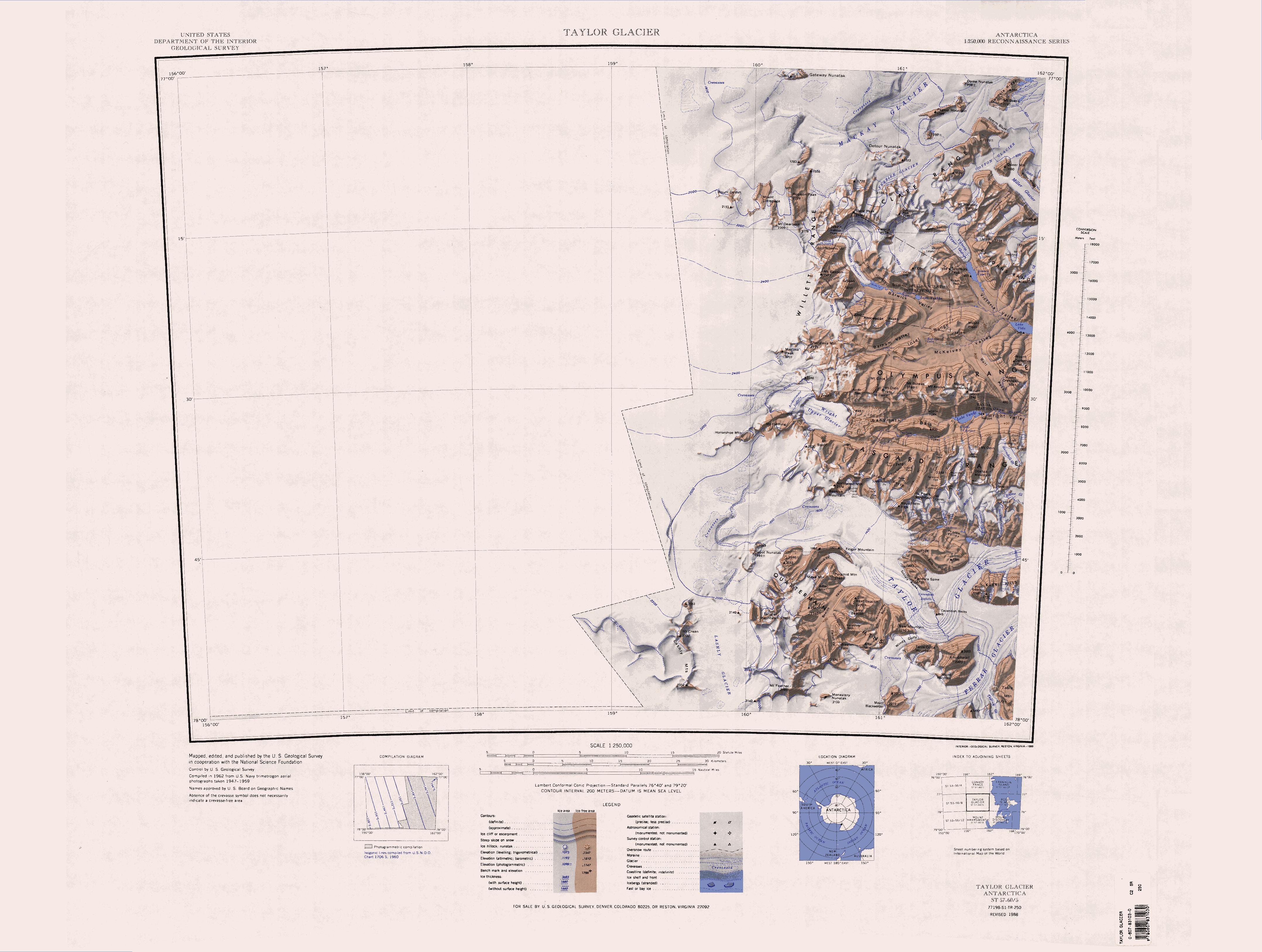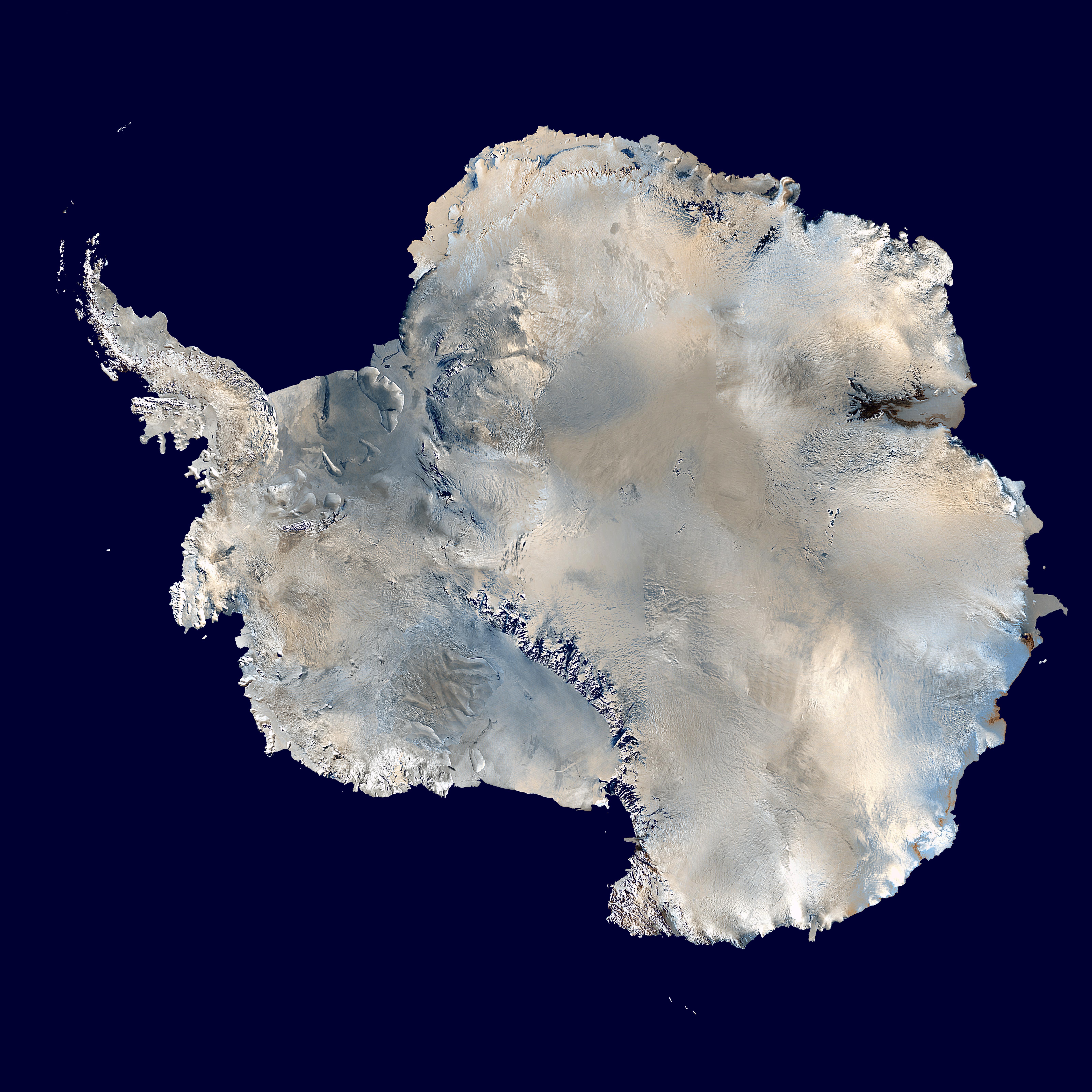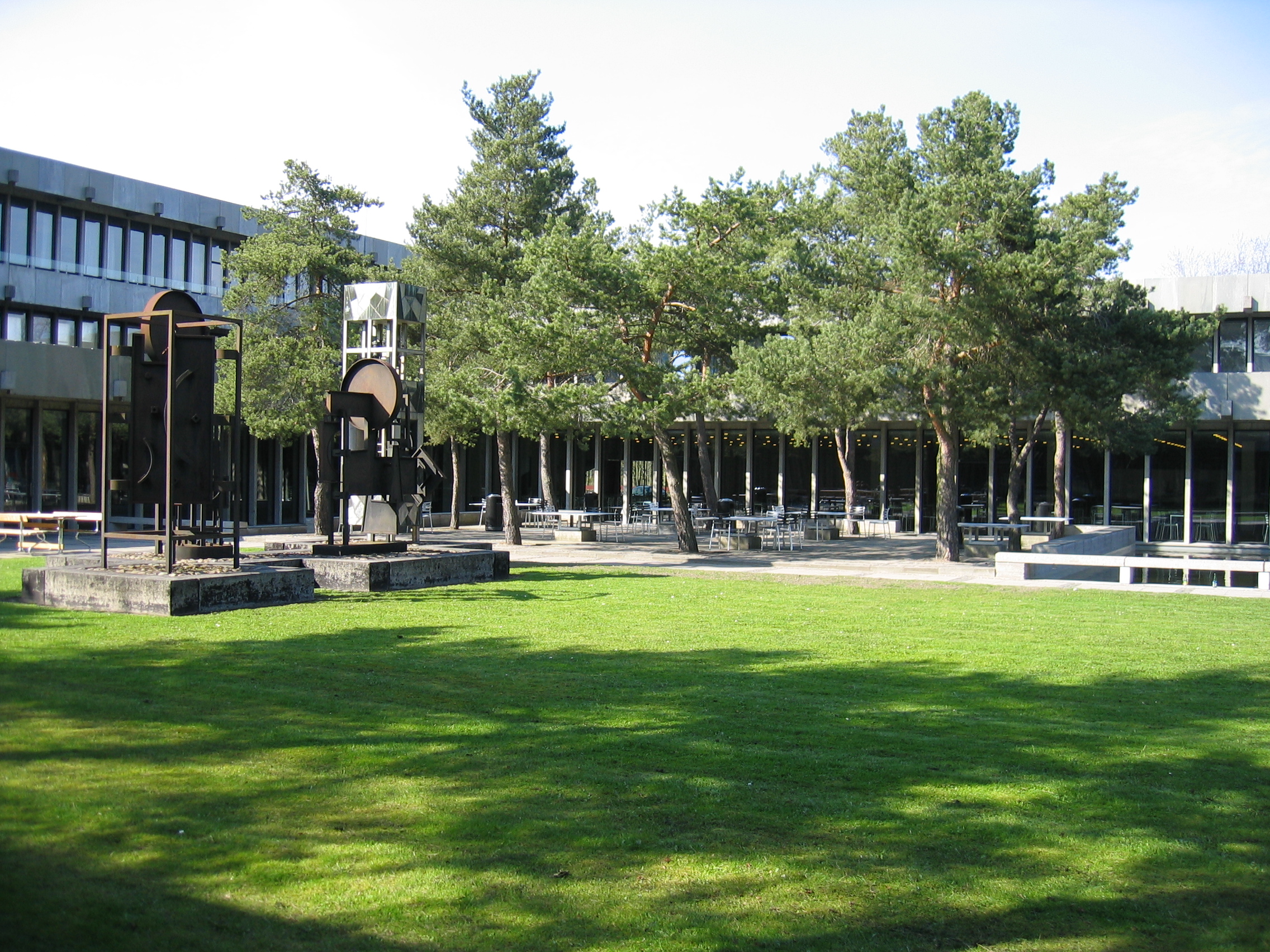|
Taylor Dome
Taylor Dome () is an elliptical ice dome, 43 nautical miles (80 km) long ESE-WNW and 16 nautical miles (30 km) wide, rising to 2,400 m, centered about 29 nautical miles (50 km) west-northwest of Mount Crean, Lashly Mountains, Victoria Land on Antarctica. The feature was delineated by the Scott Polar Research Institute (SPRI)-National Science Foundation (NSF)-Technical University of Denmark (TUD) airborne radio echo sounding program, 1967–79. The name was first used by David J. Drewry of SPRI in 1980. The dome is one of the local sources of ice to the Taylor Glacier, from which it is named. Approved by Advisory Committee on Antarctic Names The Advisory Committee on Antarctic Names (ACAN or US-ACAN) is an advisory committee of the United States Board on Geographic Names responsible for recommending commemorative names for features in Antarctica. History The committee was established ... (US-ACAN) in 1994. Ice caps of Antarctica Bodies of ice of Oates Land [...More Info...] [...Related Items...] OR: [Wikipedia] [Google] [Baidu] |
Elliptical Dome
An elliptical dome, or an ''oval dome'', is a dome whose bottom cross-section takes the form of an ellipse. Technically, an ''ellipsoidal dome'' has a circular cross-section, so is not quite the same. While the cupola can take different geometries, when the ceiling's cross-section takes the form of an ellipse, and due to the reflecting properties of an ellipse, any two persons standing at a focus of the floor's ellipse can have one whisper, and the other hears; this is a whispering gallery. The largest elliptical dome in the world is at the Sanctuary of Vicoforte in Vicoforte, Italy. In architecture Elliptical domes have many applications in architecture; and are useful in covering rectangular spaces. The oblate, or horizontal elliptical dome is useful when there is a need to limit height of the space that would result from a spherical dome. As the mathematical description of an elliptical dome is more complex than that of spherical dome, design care is needed. In a ge ... [...More Info...] [...Related Items...] OR: [Wikipedia] [Google] [Baidu] |
Ice Cap
In glaciology, an ice cap is a mass of ice that covers less than of land area (usually covering a highland area). Larger ice masses covering more than are termed ice sheets. Description Ice caps are not constrained by topographical features (i.e., they will lie over the top of mountains). By contrast, ice masses of similar size that ''are'' constrained by topographical features are known as ice fields. The ''dome'' of an ice cap is usually centred on the highest point of a massif. Ice flows away from this high point (the ice divide) towards the ice cap's periphery. Ice caps have significant effects on the geomorphology of the area that they occupy. Plastic moulding, gouging and other glacial erosional features become present upon the glacier's retreat. Many lakes, such as the Great Lakes in North America, as well as numerous valleys have been formed by glacial action over hundreds of thousands of years. On Earth, there are about of total ice mass. The average temper ... [...More Info...] [...Related Items...] OR: [Wikipedia] [Google] [Baidu] |
Mount Crean
Mount Crean is one of the westernmost peaks in the dry valley region of South Victoria Land in Antarctica. It lies at , rises to , and is the highest summit in the Lashly Mountains. It is named after the Irish explorer Tom Crean, who was a member of both of Captain Scott's Antarctic expeditions ( Discovery, 1901–04 and Terra Nova, 1910–13), and served as second officer on Sir Ernest Shackleton's Imperial Trans-Antarctic Expedition, 1914–17. In the 2000–01 summer season a meteorite was found on Mount Crean by a geological party. There is also a Mount Crean in Greenland Greenland ( kl, Kalaallit Nunaat, ; da, Grønland, ) is an island country in North America that is part of the Kingdom of Denmark. It is located between the Arctic and Atlantic oceans, east of the Canadian Arctic Archipelago. Greenland is .... Sources * * References {{reflist Crean McMurdo Dry Valleys ... [...More Info...] [...Related Items...] OR: [Wikipedia] [Google] [Baidu] |
Lashly Mountains
The Lashly Mountains () are a small group of mountains, the most prominent at being Mount Crean, standing south of the head of Taylor Glacier and west of Lashly Glacier, in Victoria Land, Antarctica. Exploration and naming The Lashly Mountains were discovered by the British National Antarctic Expedition (1901–04) and named for William Lashly, a member of the party which explored this area. Location The Lashley Mountains are on the edge of the East Antarctic Ice Sheet. They are west of the Quartermain Mountains and Mount Feather, from which they are separated by the Lashly Glacier, which flows south into The Portal. Mount Crean is the highest peak of the range. Portal Mountain lies to the south of the range, above the Skelton Névé. Geology The Lashly Mountains lie between the intrusive rocks of the McMurdo Dry Valleys and the extrusive rocks of the Transantarctic Mountains. Samples from an unnamed nunatak north of Mount Crean indicated an extrusive origin. The Lashly F ... [...More Info...] [...Related Items...] OR: [Wikipedia] [Google] [Baidu] |
Victoria Land
Victoria Land is a region in eastern Antarctica which fronts the western side of the Ross Sea and the Ross Ice Shelf, extending southward from about 70°30'S to 78°00'S, and westward from the Ross Sea to the edge of the Antarctic Plateau. It was discovered by Captain James Clark Ross in January 1841 and named after Queen Victoria. The rocky promontory of Minna Bluff is often regarded as the southernmost point of Victoria Land, and separates the Scott Coast to the north from the Hillary Coast of the Ross Dependency to the south. The region includes ranges of the Transantarctic Mountains and the McMurdo Dry Valleys (the highest point being Mount Abbott in the Northern Foothills), and the flatlands known as the Labyrinth. The Mount Melbourne is an active volcano in Victoria Land. Early explorers of Victoria Land include James Clark Ross and Douglas Mawson. In 1979, scientists discovered a group of 309 meteorites A meteorite is a solid piece of debris from an ... [...More Info...] [...Related Items...] OR: [Wikipedia] [Google] [Baidu] |
Antarctica
Antarctica () is Earth's southernmost and least-populated continent. Situated almost entirely south of the Antarctic Circle and surrounded by the Southern Ocean, it contains the geographic South Pole. Antarctica is the fifth-largest continent, being about 40% larger than Europe, and has an area of . Most of Antarctica is covered by the Antarctic ice sheet, with an average thickness of . Antarctica is, on average, the coldest, driest, and windiest of the continents, and it has the highest average elevation. It is mainly a polar desert, with annual precipitation of over along the coast and far less inland. About 70% of the world's freshwater reserves are frozen in Antarctica, which, if melted, would raise global sea levels by almost . Antarctica holds the record for the lowest measured temperature on Earth, . The coastal regions can reach temperatures over in summer. Native species of animals include mites, nematodes, penguins, seals and tardigrades. Where ve ... [...More Info...] [...Related Items...] OR: [Wikipedia] [Google] [Baidu] |
Scott Polar Research Institute
The Scott Polar Research Institute (SPRI) is a centre for research into the polar regions and glaciology worldwide. It is a sub-department of the Department of Geography in the University of Cambridge, located on Lensfield Road in the south of Cambridge. SPRI was founded by Frank Debenham in 1920 as the national memorial to Captain Robert Falcon Scott and his companions, who died on their return journey from the South Pole in 1912. It investigates issues relevant to the Arctic and Antarctic in the environmental sciences, social sciences and humanities. The institute is home the Polar Museum and has some 60 personnel, consisting of academic, library and support staff plus postgraduate students, associates and fellows attached to research programmes. The institute also hosts the Scientific Committee on Antarctic Research. Research SPRI has several research groups. Notable researchers that have been based at the institute include Julian Dowdeswell, British diplomat Bry ... [...More Info...] [...Related Items...] OR: [Wikipedia] [Google] [Baidu] |
National Science Foundation
The National Science Foundation (NSF) is an independent agency of the United States government that supports fundamental research and education in all the non-medical fields of science and engineering. Its medical counterpart is the National Institutes of Health. With an annual budget of about $8.3 billion (fiscal year 2020), the NSF funds approximately 25% of all federally supported basic research conducted by the United States' colleges and universities. In some fields, such as mathematics, computer science, economics, and the social sciences, the NSF is the major source of federal backing. The NSF's director and deputy director are appointed by the President of the United States and confirmed by the United States Senate, whereas the 24 president-appointed members of the National Science Board (NSB) do not require Senate confirmation. The director and deputy director are responsible for administration, planning, budgeting and day-to-day operations of the foundation, whi ... [...More Info...] [...Related Items...] OR: [Wikipedia] [Google] [Baidu] |
Technical University Of Denmark
The Technical University of Denmark ( da, Danmarks Tekniske Universitet), often simply referred to as DTU, is a polytechnic university and school of engineering. It was founded in 1829 at the initiative of Hans Christian Ørsted as Denmark's first polytechnic, and it is today ranked among Europe's leading engineering institutions. It is located in the town Kongens Lyngby, north of central Copenhagen, Denmark. Along with École Polytechnique in Paris, École Polytechnique Fédérale de Lausanne, Eindhoven University of Technology, Technical University of Munich and Technion – Israel Institute of Technology, DTU is a member of EuroTech Universities Alliance. History DTU was founded in 1829 as the "College of Advanced Technology" (Danish: Den Polytekniske Læreanstalt). The Physicist Hans Christian Ørsted, at that time a professor at the University of Copenhagen, was one of the driving forces behind this initiative. He was inspired by the École Polytechnique in Paris, Franc ... [...More Info...] [...Related Items...] OR: [Wikipedia] [Google] [Baidu] |
David J
David John Haskins (born 24 April 1957, Northampton, Northamptonshire, England), better known as David J, is a British alternative rock musician, producer, and writer. He is the bassist for the gothic rock band Bauhaus and for Love and Rockets. He has composed the scores for a number of plays and films, and also wrote and directed his own plays, ''Silver for Gold (The Odyssey of Edie Sedgwick)'', in 2008, which was restaged at REDCAT in Los Angeles in 2011, and ''The Chanteuse and The Devil's Muse'' in 2011. His artwork has been shown in galleries internationally, and he has been a resident DJ at venues such as the Knitting Factory. David J has released a number of singles and solo albums, and in 1990 he released one of the first No. 1 hits on the then nascent Modern Rock Tracks charts, with "I'll Be Your Chauffeur". His most recent single, "The Day That David Bowie Died" entered the UK vinyl singles chart at number 4 in 2016. The track appears on his double album, ''V ... [...More Info...] [...Related Items...] OR: [Wikipedia] [Google] [Baidu] |
Taylor Glacier
__NOTOC__ The Taylor Glacier is an Antarctic glacier about long, flowing from the plateau of Victoria Land into the western end of Taylor Valley, north of the Kukri Hills, south of the Asgard Range. The middle part of the glacier is bounded on the north by the Inland Forts and on the south by Beacon Valley. History The glacier was discovered by the British National Antarctic Expedition (1901–04) and at that time thought to be a part of Ferrar Glacier. The Western Journey Party of the British Antarctic Expedition of 1910 determined that the upper and lower portions of what was then known as Ferrar Glacier are apposed, i.e., joined in Siamese-twin fashion north of Knobhead. With this discovery Robert Falcon Scott named the upper portion for Thomas Griffith Taylor, geologist and leader of the Western Journey Party. Glaciology Research The Taylor Glacier has been the focus of a measurement and modeling effort carried out by researchers from the University of California, ... [...More Info...] [...Related Items...] OR: [Wikipedia] [Google] [Baidu] |
Advisory Committee On Antarctic Names
The Advisory Committee on Antarctic Names (ACAN or US-ACAN) is an advisory committee of the United States Board on Geographic Names responsible for recommending commemorative names for features in Antarctica. History The committee was established in 1943 as the Special Committee on Antarctic Names (SCAN). It became the Advisory Committee on Antarctic Names in 1947. Fred G. Alberts was Secretary of the Committee from 1949 to 1980. By 1959, a structured nomenclature was reached, allowing for further exploration, structured mapping of the region and a unique naming system. A 1990 ACAN gazeeter of Antarctica listed 16,000 names. Description The United States does not recognise territorial boundaries within Antarctica, so ACAN assigns names to features anywhere within the continent, in consultation with other national nomenclature bodies where appropriate, as defined by the Antarctic Treaty System. The research and staff support for the ACAN is provided by the United States Geolog ... [...More Info...] [...Related Items...] OR: [Wikipedia] [Google] [Baidu] |





